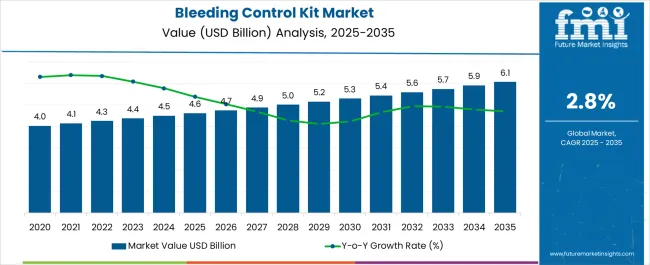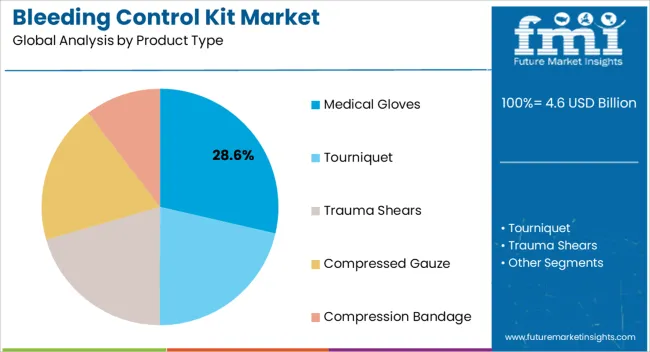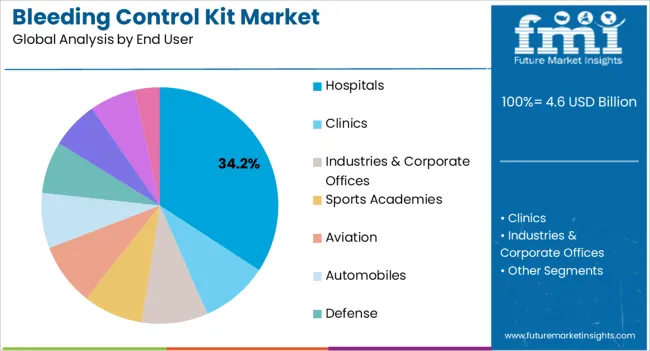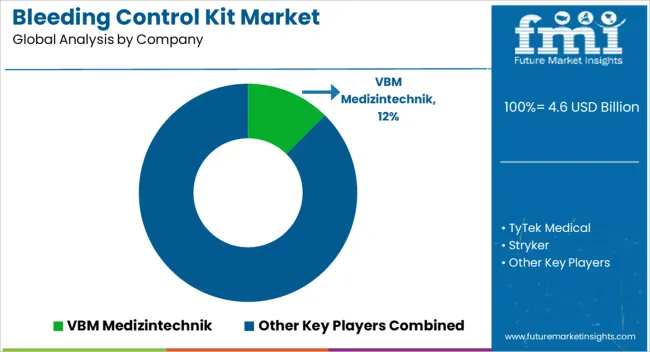The Bleeding Control Kit Market is estimated to be valued at USD 4.6 billion in 2025 and is projected to reach USD 6.1 billion by 2035, registering a compound annual growth rate (CAGR) of 2.8% over the forecast period.

| Metric | Value |
|---|---|
| Bleeding Control Kit Market Estimated Value in (2025 E) | USD 4.6 billion |
| Bleeding Control Kit Market Forecast Value in (2035 F) | USD 6.1 billion |
| Forecast CAGR (2025 to 2035) | 2.8% |
The bleeding control kit market is expanding steadily, supported by the rising prevalence of trauma cases, increasing focus on emergency preparedness, and heightened awareness of first-response interventions. Healthcare authorities and clinical publications have emphasized the critical importance of timely bleeding control to reduce mortality from accidents, violence, and occupational injuries.
Government initiatives and institutional investments in equipping public spaces, schools, and workplaces with bleeding control kits have further enhanced market demand. Additionally, medical device companies have diversified their product portfolios with user-friendly, compact, and portable kits designed for both professional and layperson use.
Hospitals and emergency medical services have integrated bleeding control kits as a standard part of trauma care protocols, ensuring faster intervention during critical cases. Looking ahead, market growth is expected to be accelerated by rising adoption in civilian environments, regulatory support for standardized emergency equipment, and continuous innovations in kit components, with particular focus on accessibility, sterility, and ease of deployment.

The Medical Gloves segment is projected to account for 28.60% of the bleeding control kit market revenue in 2025, reflecting its indispensable role in infection prevention during emergency interventions. Growth of this segment has been driven by heightened emphasis on personal protection and sterile handling during bleeding control procedures.
Hospitals and emergency services have mandated the inclusion of gloves in every kit to ensure compliance with occupational safety standards and reduce the risk of cross-contamination. Industry updates have highlighted innovations in glove materials, including latex-free and hypoallergenic variants, enhancing comfort and usability in diverse clinical and non-clinical settings.
Additionally, consumer awareness campaigns on first aid and public preparedness have reinforced the importance of gloves as an essential barrier device. With growing concerns over bloodborne pathogen exposure and global demand for standardized trauma kits, the Medical Gloves segment is expected to sustain its leading share among kit components.

The Hospitals segment is projected to contribute 34.20% of the bleeding control kit market revenue in 2025, maintaining its position as the leading end-user segment. This dominance has been supported by hospitals’ central role in trauma care and emergency interventions, where immediate bleeding control is critical for patient survival.
Clinical practice guidelines have mandated the availability of bleeding control kits across emergency departments, surgical wards, and trauma units, reinforcing hospital demand. Additionally, institutional purchasing power and bulk procurement agreements have enabled hospitals to secure advanced kits with specialized components.
Hospitals have also been at the forefront of training healthcare professionals in rapid bleeding management techniques, increasing kit utilization. Investor briefings and hospital infrastructure reports have cited rising investment in emergency preparedness, further driving adoption. As trauma care protocols evolve and hospital systems prioritize rapid-response readiness, the Hospitals segment is expected to remain the primary consumer of bleeding control kits.
The global bleeding control kit market expanded at a CAGR of 1.9% between 2020 and 2025. Growth forecasts remain optimistic, with the market predicted to exhibit a CAGR of 2.9% between 2025 and 2035.
Rise in the funding by the federal government hence drives the adoption of bleeding control procedures and their solutions further by influencing the market.
Boost in healthcare expenditure, with the advancements in healthcare infrastructure, and growth in demand for expansion in the care for delivery positively affects the bleeding disorders treatment market.
Increasing Number of Awareness Programs by Government Bodies
The increasing number of awareness programs by government bodies to make people understand the significance of bleeding control kits after an accident occurs is likely to drive the market.
The easy availability of such kits like first aid kits, and emergency kits in supermarkets and local medical stores is another factor that is expected to augur well for the market.
The rising cases of injuries resulting from trauma which may often lead to partial paralysis are anticipated to compel healthcare professionals to deliver quick treatment to patients. This is one of the major factors that is set to boost the sales of bleeding control kits in the near future.
Lack of Skilled Healthcare Professionals
The inability of bleeding control kits to treat abrasions, frostbite, and burns may hinder their demand in specific areas. The lack of skilled healthcare professionals, especially in emerging economies is another vital factor that may hinder the growth in this market.
In addition to that, the expensive nature of state-of-the-art bleeding control procedures can decline their sales in these countries.
| Region/Country | The United States |
|---|---|
| Key Growth Factors |
|
| Key Statistic | Captured a market share of 23.2% in 2025. |
| Region/Country | North America |
|---|---|
| Key Growth Factors | Favorable reimbursement policies and government support in terms of funding positively affect the regional market. |
| Key Statistic | Estimated to record a value share of 27.8% in 2025. |
| Region/Country | China |
|---|---|
| Key Growth Factors |
|
| Key Statistic | Anticipated to develop a 4.5% CAGR from 2025 to 2035. |
| Region/Country | India |
|---|---|
| Key Growth Factors |
|
| Key Statistic | Forecasted to record at 5.2% CAGR from 2025 to 2035. |
| Category | Product |
|---|---|
| Sub Category | Tourniquet |
| Key Growth Factors |
|
| Key Statistics | Attained a market share of 37.8% in 2025. |
| Category | End-user |
|---|---|
| Sub Category | Hospitals |
| Key Growth Factors |
|
| Key Statistics | Captured a market share of 27.3%% in 2025. |

Some of the leading companies operating in the global bleeding control supplies market include VBM Medizintechnik, TyTek Medical, Stryker, Hammarplast Medical, Tactical Medical Solutions, Friedrich Bosch Medizintechnik, North American Rescue, Rudolf Riester, Zimmer Biomet, Cardinal Health, Delfi Medical, and Ulrich Medical among others.
The majority of the leading players are focusing on expanding their geographic presence by developing new manufacturing facilities, especially in the untapped regions. Meanwhile, a few other companies are aiming to launch novel products and engage in collaborations with local firms to gain a competitive edge in this market.
Some of the new developments are-
| Report Attribute | Details |
|---|---|
| Growth Rate | CAGR of 2.8% from 2025 to 2035 |
| Base Year for Estimation | 2025 |
| Historical Data | 2020 to 2025 |
| Forecast Period | 2025 to 2035 |
| Quantitative Units | Revenue in USD million and CAGR from 2025 to 2035 |
| Report Coverage | Revenue Forecast, Volume Forecast, Company Ranking, Competitive Landscape, Growth Factors, Trends and Pricing Analysis |
| Segments Covered | Product Type, End User, Region |
| Regions Covered | North America; Latin America; Western Europe; Eastern Europe; South Asia and Pacific; East Asia; The Middle East and Africa |
| Key Countries Profiled | The United States, Canada, Brazil, Mexico, Rest of Latin America, Germany, The United Kingdom, France, Spain, Italy, Rest of Western Europe, Poland, Russia, Czech Republic, Romania, Rest of Eastern Europe, India, Bangladesh, Australia, New Zealand, Rest of South Asia and the Pacific, China, Japan, South Korea, GCC countries, South Africa, Israel, Rest of the Middle East and Africa |
| Key Companies Profiled | VBM Medizintechnik; TyTek Medical; Stryker; Hammarplast Medical; Tactical Medical Solutions; Friedrich Bosch Medizintechnik; North American Rescue; Rudolf Riester; Zimmer Biomet; Cardinal Health |
The global bleeding control kit market is estimated to be valued at USD 4.6 billion in 2025.
The market size for the bleeding control kit market is projected to reach USD 6.1 billion by 2035.
The bleeding control kit market is expected to grow at a 2.8% CAGR between 2025 and 2035.
The key product types in bleeding control kit market are medical gloves, tourniquet, trauma shears, compressed gauze and compression bandage.
In terms of end user, hospitals segment to command 34.2% share in the bleeding control kit market in 2025.






Full Research Suite comprises of:
Market outlook & trends analysis
Interviews & case studies
Strategic recommendations
Vendor profiles & capabilities analysis
5-year forecasts
8 regions and 60+ country-level data splits
Market segment data splits
12 months of continuous data updates
DELIVERED AS:
PDF EXCEL ONLINE
Bleeding Disorder Testing Market Size and Share Forecast Outlook 2025 to 2035
Bleeding Control Tablets Market Analysis - Growth, Applications & Outlook 2025 to 2035
Control Room Solution Market Size and Share Forecast Outlook 2025 to 2035
Control Knobs for Panel Potentiometer Market Size and Share Forecast Outlook 2025 to 2035
Controlled-Release Drug Delivery Technology Market Size and Share Forecast Outlook 2025 to 2035
Controlled Environment Agriculture (CEA) Market Size and Share Forecast Outlook 2025 to 2035
Control Cable Market Size and Share Forecast Outlook 2025 to 2035
Control Towers Market Size and Share Forecast Outlook 2025 to 2035
Controlled & Slow Release Fertilizers Market 2025-2035
Controlled Intelligent Packaging Market
Biocontrol Solutions Market Size and Share Forecast Outlook 2025 to 2035
Biocontrol Agents Market Size and Share Forecast Outlook 2025 to 2035
Oil Control Shampoo Market Size and Share Forecast Outlook 2025 to 2035
LED Control Unit Market Size and Share Forecast Outlook 2025 to 2035
Sun Control Films Market Size and Share Forecast Outlook 2025 to 2035
CNC Controller Market Size and Share Forecast Outlook 2025 to 2035
PID Controller Market Size and Share Forecast Outlook 2025 to 2035
Market Share Breakdown of Sun Control Films Manufacturers
PLC Controlled Packing Machine Market Trends – Forecast 2024-2034
HVAC Control System Market Size and Share Forecast Outlook 2025 to 2035

Thank you!
You will receive an email from our Business Development Manager. Please be sure to check your SPAM/JUNK folder too.
Chat With
MaRIA